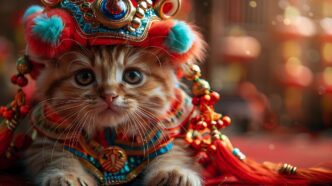Quick Takeaway
Animal & Element Origin
Impact on Personality
Diverse Interpretations
The ancient wisdom of the Chinese Zodiac, with its twelve distinct animal archetypes and their associated personality traits, subtly yet profoundly shapes the narratives we consume every day across movies, television shows, and literature. For centuries, these zodiac signs have offered a universal framework for understanding human nature, making them invaluable, often unconscious, templates for character development, plot dynamics, and thematic explorations by creators worldwide. This pervasive influence allows audiences to connect deeply with fictional personalities, recognizing echoes of these timeless archetypes in heroes, villains, and supporting characters alike, thereby enriching our engagement with storytelling.
The Archetypal Blueprint of the Chinese Zodiac
At its core, the Chinese Zodiac provides a sophisticated system of personality profiling, assigning specific attributes, strengths, weaknesses, and even destinies to individuals born under each animal sign. These twelve animals—Rat, Ox, Tiger, Rabbit, Dragon, Snake, Horse, Goat, Monkey, Rooster, Dog, and Pig—represent a cyclical journey through life’s experiences and characteristics. Each sign embodies a complete psychological profile, making them perfect springboards for crafting believable and compelling fictional beings.
Writers and producers, whether intentionally or intuitively, draw upon these well-established archetypes to imbue their characters with immediate recognition and depth. A character who exhibits the diligence of an Ox or the charisma of a Dragon instantly resonates with audiences familiar with these symbolic meanings. This resonance creates a shorthand for understanding complex personalities and predicting potential actions within a narrative.
Zodiac Signs in Storytelling: Character & Conflict
The influence of the Chinese Zodiac extends far beyond simple character traits; it informs the very conflicts, relationships, and journeys that drive our favorite stories. By examining how each sign’s essence manifests in popular culture, we can uncover a hidden layer of meaning.
The Resourceful Rat
Characters embodying the Rat are often clever, ambitious, and quick-witted, possessing an innate ability to find solutions where others see none. They are survivors, often thriving in challenging environments, and can be both charming and cunning. Think of the street-smart protagonists who outwit their adversaries with intelligence rather than brute force.
The Steadfast Ox
The Ox archetype is defined by strength, diligence, and unwavering determination. These characters are often the pillars of their communities, reliable and hardworking, though sometimes stubborn or resistant to change. They are the silent heroes, whose steadfastness ultimately brings stability or achieves monumental tasks.
The Daring Tiger
Tigers are brave, adventurous, and fiercely independent, often leading with charisma and a rebellious spirit. They are natural leaders who inspire loyalty but can also be impulsive or prone to dramatic actions. Many epic heroes and revolutionary figures in fiction draw heavily from the Tiger’s bold essence.
The Gentle Rabbit
Rabbits are typically gentle, artistic, and cautious, valuing peace and harmony above all else. They are often intelligent and diplomatic, though they might appear timid or overly sensitive. Characters who embody the Rabbit sign often achieve their goals through quiet wisdom and strategic thinking, proving that strength comes in many forms.
The Majestic Dragon
The Dragon is perhaps the most potent and revered sign, representing power, charisma, ambition, and nobility. Dragon characters are often destined for greatness, whether as benevolent leaders or formidable antagonists. Their narratives frequently involve grand challenges and the pursuit of ultimate authority or influence.
The Enigmatic Snake
Snakes are wise, intuitive, and often enigmatic, possessing a keen sense of perception and a mysterious allure. They are strategic thinkers, capable of great depth and sometimes, great vengeance. Characters inspired by the Snake are often the master manipulators, the wise mentors, or the compelling anti-heroes whose true motives remain elusive.
The Free-Spirited Horse
Horses are energetic, independent, and love freedom, often embodying a restless spirit and a desire for adventure. They are passionate and enthusiastic but can also be impatient or impulsive. Characters who are wanderers, rebels, or fiercely loyal companions on epic journeys often reflect the Horse’s spirited nature.
The Compassionate Goat (Sheep)
Goats are gentle, compassionate, and artistic, often possessing a strong sense of empathy and a desire for beauty. They can be indecisive or prone to worry but bring warmth and creativity to their stories. These characters are often the heart of a group, providing emotional support or inspiring through their artistic endeavors.
The Clever Monkey
Monkeys are intelligent, mischievous, and highly adaptable, with a boundless curiosity and a knack for problem-solving. They are often tricksters or brilliant strategists, capable of outwitting opponents through wit and ingenuity. Many beloved detectives, rogues, or comedic relief characters carry the Monkey’s playful and sharp mind.
The Meticulous Rooster
Roosters are observant, hardworking, and confident, often possessing a strong sense of style and a desire for perfection. They are organized and decisive but can sometimes be boastful or overly critical. Characters embodying the Rooster are often meticulous planners, dedicated professionals, or those who stand out with their distinctive presence.
The Loyal Dog
Dogs are loyal, honest, and protective, embodying a strong sense of justice and responsibility. They are faithful companions and moral compasses within their narratives, though they can sometimes be cynical or prone to worry. The quintessential sidekick, the unwavering guardian, or the principled hero often mirrors the Dog’s noble spirit.
The Generous Pig
Pigs are generous, honest, and kind-hearted, often embodying an optimistic and pleasure-seeking nature. They are benevolent figures, sometimes naive, who bring warmth and good fortune to those around them. Characters who are unexpectedly lucky, incredibly giving, or who find simple joy in life often channel the Pig’s inherent goodness.
Beyond the Animal: Elemental Cycles and Yin/Yang
The depth of the Chinese Zodiac’s influence extends beyond just the animal signs to incorporate the Five Elements (Wood, Fire, Earth, Metal, Water) and the principles of Yin and Yang. These additional layers add nuance, allowing creators to craft characters with even greater specificity. For instance, a Fire Dragon might be more volatile and ambitious than a Water Dragon, who would be more intuitive and adaptable. This elemental interplay explains why two characters sharing the same animal sign can still exhibit vastly different personalities and motivations, providing a richer palette for storytellers.
The push and pull of Yin and Yang also inform character dynamics, creating natural tensions and harmonies. A character embodying strong Yang energy (assertive, outward, dominant) might naturally clash or complement a character with strong Yin energy (receptive, inward, subtle). These ancient philosophical concepts provide a foundational grammar for character interaction and conflict resolution in storytelling.
The Unconscious Tapestry of Narrative
Whether writers and directors explicitly consult Chinese astrological charts or simply tap into a collective unconscious understanding of these archetypes, the impact is undeniable. The Chinese Zodiac offers a time-tested framework for understanding human behavior and interaction, providing a universal language for character development. This allows for the creation of characters that feel inherently familiar and relatable, regardless of the audience’s cultural background.
From the epic quests of fantasy sagas to the intricate relationships in dramatic television series, the twelve animals and their associated traits provide a robust, versatile toolkit for narrative construction. These archetypes not only define who characters are but also dictate their likely responses to challenges, their relationships with others, and their ultimate narrative arcs, making stories feel both authentic and compelling.
Conclusion
The enduring power of the Chinese Zodiac lies in its ability to encapsulate fundamental aspects of the human condition, making it a profound, if often unseen, force in shaping our favorite movies, TV shows, and books. By recognizing these ancient archetypes woven into the fabric of modern storytelling, we gain a deeper appreciation for the creative process and the timeless wisdom embedded within these cherished narratives. The next time you encounter a character who is cunning, steadfast, or adventurous, consider which zodiac animal might be their guiding spirit, and unlock a new layer of understanding in their story.








